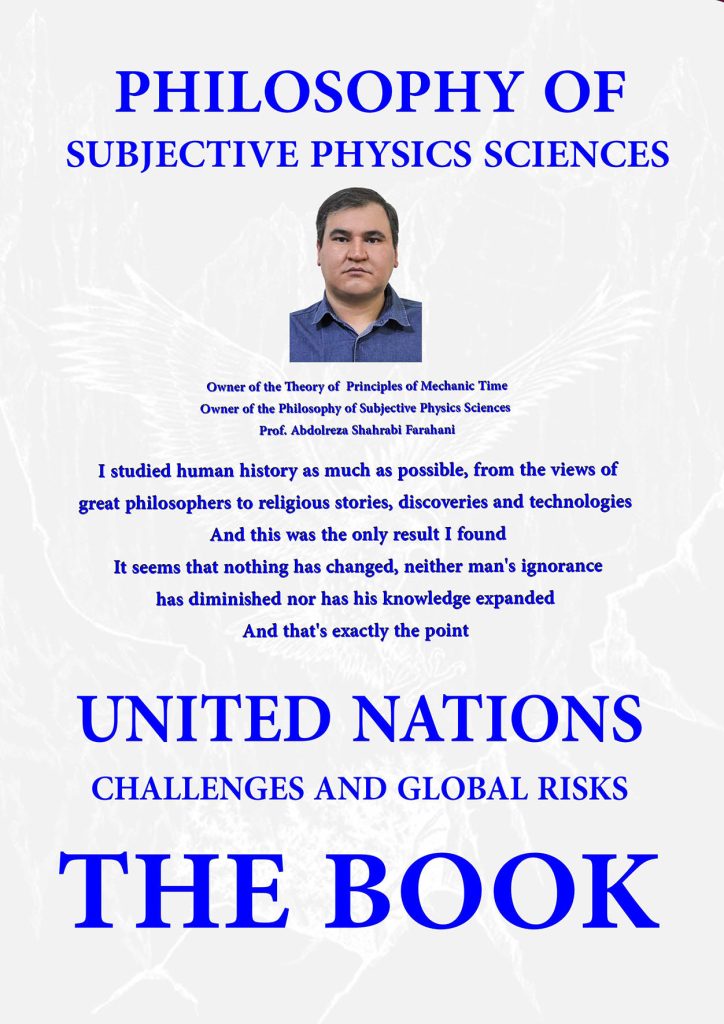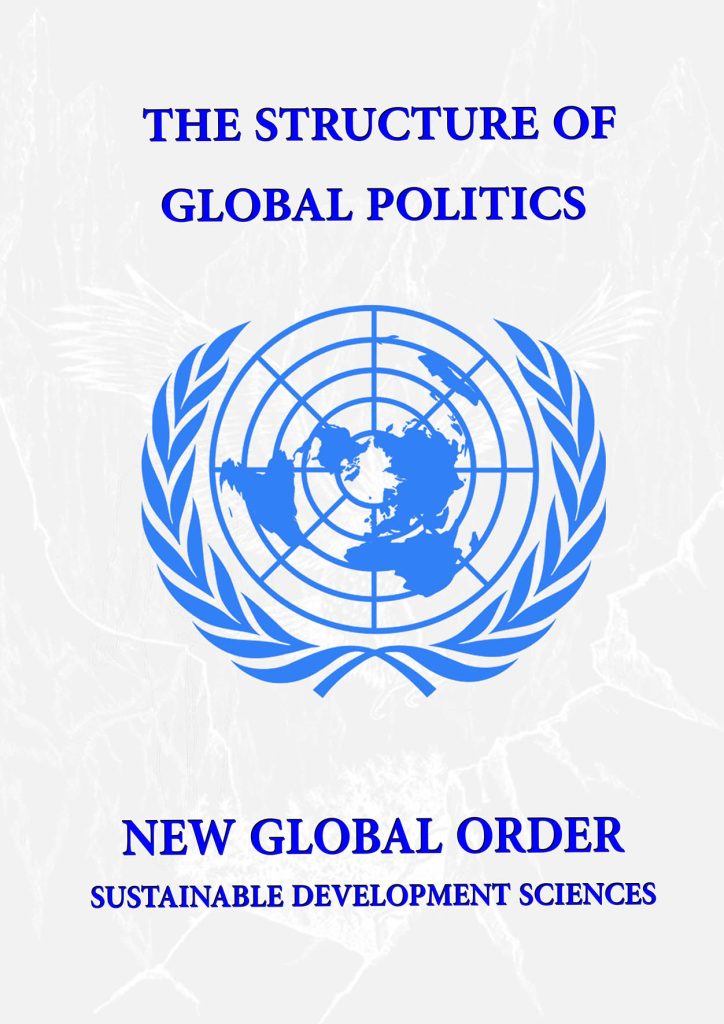


Author: Prof. Abdolreza Shahrabi Farahani
The Owner of the Philosophy and Theory of Principles of Mechanic Time
The Owner of the Philosophy of Subjective Physics Sciences

Author’s Senior Advisor: Prof. Seyed Vahab Mirsalehi
Philosophy of Kant and Nietzsche – Oriental Sciences and Philosophy

Author’s Senior Advisor: Dr. Mohammad Reza Zamani Darmazari
Chief of the International Law Commission and Human Rights at UNESCO MIL APAC and WSSPS
——————————————————————————————————-
The (Subjective Physics Sciences) is a non-governmental organization in consultative status with the
United Nations Economic and Social Council since [ECOSOC Special Consultative Status, Since 2023].
Introduction
The book titled “United Nations, Challenges and Global Risks” is a result of the author, Professor Abdolreza Shahrabi Farahani, experiences and observations from May 2013 to the present. Throughout this period, the author actively participated in conferences, meetings, and summits held at various United Nations locations such as the United Nations Office in Vienna, the Palace of Nations in Geneva, and the United Nations Headquarters in New York, including the Security Council.
The author’s engagement in these events provided them with firsthand exposure to the activities and discussions taking place within the United Nations. Over the course of several one month, the author meticulously documented these experiences and transformed them into a comprehensive book.
The book delves into the details of each meeting, examining the participation of various stakeholders, representatives, ambassadors, and non-governmental organizations (NGOs). It covers a wide range of topics discussed within the United Nations and presents the author’s personal opinions based on their observations.
While the author’s reviews may appear critical at times, they aim to express their genuine assessments and insights. These criticisms serve as constructive feedback, highlighting areas where the United Nations could potentially improve its performance. By paying attention to these critiques, positive changes can be observed and implemented. Understanding the complexities surrounding the United Nations and its operations was not an easy task.
The author faced challenges in unraveling the intricacies of the issues discussed. To ensure a comprehensive analysis, the author sought the guidance and advice of two professors “Prof. Seyed Vahab Mirsalehi” and “Dr. Mohammad Reza Zamani Darmazari” specializing in philosophy and law, enabling a deeper exploration of the subject matter.
Additionally, the book incorporates some of the author’s proposals, which were submitted to the NGO House of Nations in Geneva. These proposals outline the need for specific summits and conferences, providing reasons and justifications for their importance. By including these proposals, the book aims to contribute to the ongoing discussions and initiatives within the United Nations.
The book “United Nations, Challenges and Global Risks” draws from the author’s extensive experiences and offers a personal perspective on the functioning and performance of the United Nations.
It provides valuable insights, critical assessments, and proposals that can contribute to the development and improvement of the organization’s activities and its ability to address global challenges and risks.
1. Comprehensive Analysis: The book offers a comprehensive analysis of the United Nations by examining the author’s experiences at various United Nations locations, including Vienna, Geneva, and New York. It covers a wide range of topics discussed within the organization, providing readers with an in-depth understanding of the challenges and risks faced on a global scale.
2. Personal Opinions: The book presents the author’s personal opinions based on their observations and interactions with stakeholders involved in United Nations activities. These opinions reflect the author’s perspective on the effectiveness and shortcomings of the organization, offering a unique viewpoint that stimulates critical thinking and discussion.
3. Constructive Criticisms: While the book includes criticisms of the United Nations, it emphasizes their constructive nature. The author’s intention is to highlight areas where improvements can be made, encouraging positive changes within the organization. By addressing these criticisms, the United Nations can strive for greater effectiveness and responsiveness to global issues.
4. Collaboration with Experts: To ensure a thorough examination of the subject matter, the author collaborated with two professors specializing in philosophy and law. This collaborative effort allowed for a multidimensional analysis, incorporating different perspectives and expertise into the book’s content.
5. Proposals and Summits: The book includes proposals that the author submitted to the NGO House of Nations in Geneva. These proposals advocate for the necessity of specific summits and conferences, providing detailed reasons and justifications for their importance. By incorporating these proposals, the book contributes to the ongoing dialogue within the United Nations and offers potential avenues for addressing global challenges.
6. Weeks of Dedication: The author’s commitment to producing this book is evident through the weeks dedicated to its development. The extensive period spent documenting experiences, analyzing data, and formulating opinions demonstrates the author’s dedication to providing a comprehensive and insightful exploration of the United Nations and its global challenges.
The book “United Nations, Challenges and Global Risks” offers a personal and comprehensive perspective on the United Nations. It combines the author’s experiences, personal opinions, constructive criticisms, collaboration with experts, and proposals to contribute to the ongoing dialogue and improvement within the organization. The books thorough analysis and dedication to addressing global challenges make it a valuable resource for those interested in the workings and potential of the United Nations.
Analysis and Expansion:
The author’s text highlights significant issues related to global risks, the resistance faced by United Nations-affiliated NGOs, and the need for increased attention and respect towards their work. Building upon these points, we can expand on the author’s thoughts and provide a comprehensive analysis:
1. Inadequate Response to Global Risks: The author’s observation that many countries fail to take global risks seriously is indicative of a concerning trend. It underscores the need for nations to prioritize collective action and collaboration in addressing issues such as climate change, poverty, conflicts, and pandemics. The book can delve into specific examples and case studies to illustrate the consequences of neglecting these risks and the potential for greater cooperation.
2. Legal Pretexts and Resistance: The author’s assertion that some countries impede the activities of United Nations-affiliated NGOs under the pretext of the law sheds light on the obstacles faced by these organizations. A comprehensive exploration of such challenges can include an examination of the specific legal frameworks and regulations that hinder NGO operations, as well as the potential impact on global initiatives and progress. Additionally, the book can explore strategies to address these legal barriers and promote greater cooperation between governments and NGOs.
3. Reassessing the Role of the United Nations: The author’s concern about the United Nations being viewed as a center of global prestige while countries prioritize self-interests calls for a reevaluation of the organization’s effectiveness. The book can explore the historical context, successes, and shortcomings of the United Nations, providing a critical assessment of its role in addressing global risks. It can also offer recommendations for reforms and improvements to enhance the organization’s ability to drive collective global action.
4. Appreciating NGOs and their Contributions: Expanding on the author’s appreciation for colleagues and their tireless efforts, the book can showcase the invaluable contributions of NGOs affiliated with the United Nations. It can highlight specific initiatives, projects, and campaigns led by NGOs that have had a positive impact on various global challenges. By sharing inspiring stories and examples, the book can foster greater recognition and support for the critical work carried out by these organizations.
5. Engaging Politicians and Shaping Policies: The author’s message to world politicians emphasizes the central role of NGOs in the struggle to save the planet. The book can further explore the potential for collaboration between NGOs and policymakers, highlighting the importance of incorporating NGO perspectives, expertise, and grassroots initiatives into policy-making processes. It can also provide guidance on creating platforms for dialogue and cooperation between politicians and NGOs to foster more informed and effective decision-making.
6. A Different View of NGO Participation: Expanding on the author’s belief that the book offers a distinct perspective on NGO participation in the United Nations, it can explore innovative approaches to enhance NGO involvement. This can include examining successful models of partnership between NGOs and the United Nations, proposing structural reforms within the organization to better accommodate and integrate NGOs, and showcasing examples of effective collaboration between NGOs and governments.
7. Promoting Global Respect and Attention: The author’s call for the world to pay due respect and attention to NGOs affiliated with the United Nations can be expanded to emphasize the importance of recognizing the diverse expertise, experiences, and perspectives that NGOs bring to the global stage. The book can advocate for increased support, funding, and acknowledgment of the vital role NGOs play in addressing global risks. It can also explore mechanisms for strengthening the relationship between NGOs and the public, fostering greater understanding and engagement.
1. The Impact of Global Risks: The book can delve into the specific consequences and implications of global risks on various aspects of society, including economics, health, environment, and social stability. By providing comprehensive analyses and real-world examples, readers can gain a deeper understanding of the interconnectedness of these risks and their potential to disrupt global progress and well-being.
2. Case Studies of Successful NGO Initiatives: In order to highlight the effectiveness and impact of NGOs affiliated with the United Nations, the book can include detailed case studies of successful initiatives undertaken by these organizations. These case studies can showcase innovative approaches, collaborative partnerships, and measurable outcomes in areas such as human rights, humanitarian aid, sustainable development, and environmental conservation.
3. Overcoming Barriers and Strengthening NGO Engagement: To address the challenges faced by NGOs, the book can explore strategies and recommendations for overcoming barriers to their engagement. This can include advocating for policy reforms, creating platforms for dialogue between governments and NGOs, enhancing funding mechanisms, and promoting capacity-building initiatives to empower NGOs with the necessary resources and skills.
4. The Role of Technology and Innovation: Given the fast-paced nature of global risks, the book can explore the role of technology and innovation in addressing these challenges. It can highlight how NGOs leverage technological advancements, such as artificial intelligence, data analytics, and digital platforms, to enhance their impact, reach larger audiences, and facilitate more efficient and targeted interventions.
5. Strengthening Partnerships and Collaboration: The book can emphasize the importance of fostering multi-stakeholder partnerships and collaboration among NGOs, governments, businesses, academia, and civil society. It can discuss successful examples where these collaborations have led to greater impact, resource mobilization, and knowledge sharing, ultimately contributing to more effective solutions for global risks.
6. Amplifying Local Voices and Grassroots Movements: Recognizing that local communities often bear the brunt of global risks, the book can highlight the significance of amplifying their voices and empowering grassroots movements. By showcasing examples of community-led initiatives, the book can shed light on the power of bottom-up approaches, local knowledge, and community resilience in addressing global challenges.
7. The Role of Education and Awareness: Education and awareness play a crucial role in addressing global risks. The book can explore the importance of incorporating global citizenship education, sustainability education, and training on risk management into formal and informal educational systems. It can also highlight successful awareness campaigns and initiatives that have raised public consciousness and mobilized action on global risks.
8. Measuring Impact and Accountability: To assess the effectiveness of NGO efforts and ensure accountability, the book can discuss frameworks and methodologies for measuring impact, monitoring progress, and evaluating the outcomes of interventions. It can also address the importance of transparency, ethical practices, and responsible governance within NGOs to maintain public trust and maximize their contributions.
9. Addressing Systemic Inequalities and Global Risks: The book can delve into the intersection between systemic inequalities and global risks. It can explore how issues such as poverty, gender inequality, and unequal distribution of resources exacerbate the impact of global risks on marginalized communities. By examining these dynamics, the book can advocate for a more inclusive and equitable approach to addressing global risks, ensuring that no one is left behind.
10. Empowering Local NGOs and Community-Based Organizations: Highlighting the importance of local NGOs and community-based organizations, the book can shed light on their unique strengths and challenges. It can discuss strategies to empower and support these organizations, including capacity-building initiatives, access to funding, and strengthening networks for knowledge sharing and collaboration. By recognizing and amplifying the voices of local actors, the book can showcase the vital role they play in responding to global risks at the grassroots level.
11. Promoting Ethical Practices and Responsible Partnerships: In order to ensure the integrity and effectiveness of NGOs, the book can delve into the importance of ethical practices and responsible partnerships. It can explore topics such as transparency, accountability, and the ethical considerations surrounding NGO operations, including fundraising, data privacy, and safeguarding vulnerable populations. The book can also provide guidance on establishing and maintaining responsible partnerships with governments, businesses, and other stakeholders.
12. Mobilizing Youth and Future Generations: Recognizing the power of youth and future generations in driving change, the book can explore strategies to mobilize young people in addressing global risks. It can highlight successful youth-led initiatives, youth participation in decision-making processes, and the role of education in empowering young individuals as agents of positive change. The book can also discuss the importance of intergenerational collaboration and knowledge transfer to ensure sustainable solutions for future challenges.
13. The Role of NGOs in Conflict Prevention and Resolution: Expanding on the role of NGOs in addressing global risks, the book can specifically focus on their contributions to conflict prevention and resolution. It can explore the unique approaches employed by NGOs in promoting peacebuilding, dialogue, and reconciliation in conflict-affected regions. Case studies and examples can highlight the impact of NGO interventions in fostering sustainable peace and stability.
14. Strengthening Legal and Policy Frameworks: To support the work of NGOs and address the challenges they face, the book can advocate for the development and strengthening of legal and policy frameworks at the national and international levels. It can explore how laws and regulations can be designed to facilitate NGO operations, protect their independence, and create an enabling environment for their work. The book can also discuss the importance of advocating for policies that prioritize global risks and integrate NGO perspectives.
15. The Role of Media and Communication: Recognizing the influential role of media and communication in shaping public opinion and driving social change, the book can explore strategies for effective communication and media engagement by NGOs. It can discuss the power of storytelling, digital advocacy, and media partnerships in raising awareness about global risks and mobilizing public support. The book can also address the challenges and ethical considerations associated with media representation and messaging.
By analyzing and expanding on the author’s text, the book can provide a comprehensive exploration of global risks, the challenges faced by NGOs, the need for political engagement, and the importance of respecting their contributions. It can offer concrete recommendations, case studies, and inspiring stories to inspire change, foster collaboration, and shape a more inclusive and effective global response to the world’s most pressing challenges.
These risks encompass a wide range of challenges that have the potential to significantly impact societies and the world at large.
Global Risks
1. Rise in Inequalities
2. New Pandemic
3. Technology-driven Power Concentration
4. Economic Fragmentation
5. Large-scale Natural Hazard Risks
6. Breakdown in Cybersecurity
7. Negative Outcomes of AI and Frontier Technologies
8. Supply Chain Collapse
9. Rapid Decline in Biodiversity
10. Geoengineering Disasters
11. Proliferation of Non- State Actors (incl. criminal and terrorist groups)
12. Geopolitical Tensions
13. Shortages of Natural Resources
14. Inaction on Climate Change
15. Sustained Global Economic Stagnation
16. Global Financial Crisis
17. Bio-risks
18. Space-based Event
19. Misinformation and Disinformation
20. Collapse of Social Cohesion
21. Widespread Debt Crisis
22. Collapse in the Rule of Law and Massive Violations of Human Rights
23. Erosion of State Authority
24. Large-scale Pollution
25. Collapse of Multilateral Institutions
26. Large-scale War
27. Mass Movement of People
28. Weapons of Mass Destruction
29. The Rise of Religious Fascists
30. Global Poverty and Religious Terrorists
These risks encompass a wide range of challenges that have the potential to significantly impact societies and the world at large.
1. Rise in Inequalities: Increasing disparities in income, wealth, and opportunities, leading to social unrest and hindered development.
2. New Pandemic: The outbreak of a new infectious disease with the potential to spread rapidly and cause significant global health crises.
3. Technology-driven Power Concentration: The concentration of power and influence in the hands of a few dominant technology companies or countries, leading to concerns related to privacy, control, and equity.
4. Economic Fragmentation: Disintegration of the global economy due to trade disputes, protectionism, and the erosion of multilateral trade agreements.
5. Large-scale Natural Hazard Risks: Risks associated with natural disasters such as earthquakes, tsunamis, hurricanes, and floods, which can cause widespread destruction and loss of life.
6. Breakdown in Cybersecurity: Vulnerabilities in digital systems leading to cyberattacks, data breaches, and disruptions to critical infrastructure.
7. Negative Outcomes of AI and Frontier Technologies: Potential adverse impacts of artificial intelligence (AI) and other emerging technologies, such as job displacement, ethical concerns, and unintended consequences.
8. Supply Chain Collapse: Disruptions or collapses in global supply chains due to factors like natural disasters, conflicts, or economic shocks, leading to shortages and economic instability.
9. Rapid Decline in Biodiversity: Loss of species and ecosystems at an alarming rate, threatening ecosystems, food security, and the stability of the planet.
10. Geoengineering Disasters: Unintended consequences or failures in large-scale climate engineering projects intended to mitigate climate change.
11. Proliferation of Non-State Actors (incl. criminal and terrorist groups): The rise of non-state actors, including criminal organizations and terrorist groups, posing security threats and destabilizing regions.
12. Geopolitical Tensions: Heightened tensions between countries, often driven by territorial disputes, political rivalries, or resource competition.
13. Shortages of Natural Resources: Depletion of essential resources such as water, energy, minerals, and arable land, leading to conflicts and economic disruptions.
14. Inaction on Climate Change: Failure to mitigate and adapt to climate change, resulting in severe environmental consequences, including extreme weather events, rising sea levels, and ecosystem disruptions.
15. Sustained Global Economic Stagnation: Prolonged period of slow economic growth, high unemployment, and reduced investment, impacting livelihoods and social stability.
16. Global Financial Crisis: A severe disruption in global financial markets, often characterized by bank failures, credit crunches, and economic recession.
17. Bio-risks: Risks associated with the outbreak or release of infectious diseases, including deliberate Bio-attacks or accidental laboratory leaks.
18. Space-based Event: Catastrophic events occurring in outer space, such as satellite collisions or solar flares, disrupting critical communication and navigation systems.
19. Misinformation and Disinformation: The spread of false or misleading information, leading to societal divisions, erosion of trust, and compromised decision-making processes.
20. Collapse of Social Cohesion: Loss of social cohesion and trust within societies, leading to increased polarization, conflicts, and weakened governance structures.
21. Widespread Debt Crisis: Accumulation of unsustainable levels of public and private debt, leading to economic instability and potential default on financial obligations.
22. Collapse in the Rule of Law and Massive Violations of Human Rights: Erosion of legal frameworks, institutions, and respect for human rights, resulting in social unrest, violence, and injustices.
23. Erosion of State Authority: Weakening of governmental institutions, loss of control over territories, and the rise of ungoverned spaces.
24. Large-scale Pollution: Pollution of air, water, and land on a significant scale, resulting in adverse health effects, ecosystem degradation, and climate impacts.
25. Collapse of Multilateral Institutions: A breakdown in international cooperation and the weakening of multilateral organizations, impeding collective efforts to address global challenges.
26. Large-scale War: Outbreak of armed conflicts on a global scale, leading to widespread destruction, loss of life, and humanitarian crises.
27. Mass Movement of People: Large-scale displacement of people due to conflicts, natural disasters, or socio-economic factors, resulting in humanitarian emergencies and strains on host countries.
28. Weapons of Mass Destruction: The proliferation and potential use of nuclear, chemical, or biological weapons, posing grave threats to global security.
29. The Rise of Religious Fascists: The emergence of extremist ideologies and movements that promote religious fundamentalism, intolerance, and violence.
30. Global Poverty and Religious Terrorists: Widespread poverty, inequality, and the rise of terrorist organizations exploiting grievances, religious extremism, and socio-economic disparities.
The United Nations and its member states work together to address these global risks through various mechanisms, including policy coordination, international cooperation, and the implementation of sustainable development goals.
The UN plays a crucial role in promoting dialogue, facilitating negotiations, and coordinating efforts to mitigate these risks and build a more resilient and sustainable future for all.
